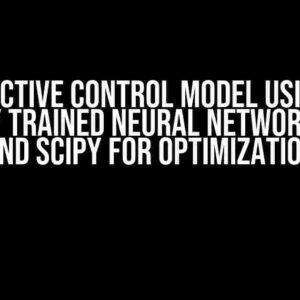Ah, the infamous vanishing gradient problem in Transformers! You’re not alone in this struggle, my friend. Many a brave soul has ventured into the realm of sequence-to-sequence models, only to be thwarted by this pesky issue. Fear not, dear reader, for we shall embark on a quest to vanquish this beast and restore the health of your gradients!
What is the Vanishing Gradient Problem?
The vanishing gradient problem is a phenomenon where the gradients used to update the model’s parameters during backpropagation become smaller and smaller as they flow through the network. This can cause the model to converge very slowly or not at all, especially in deep networks like Transformers.
Imagine you’re trying to communicate with a friend who’s standing at the top of a mountain. You shout a message, but by the time it reaches the top, it’s barely audible. That’s what’s happening with the gradients in your Transformer model. The signal is getting lost in translation, and your model is suffering as a result.
Why Does it Happen in Transformers?
Transformers, being based on self-attention mechanisms, are more prone to the vanishing gradient problem due to several reasons:
- Deep Encoder-Decoder Architecture: The Transformer architecture consists of multiple encoder and decoder layers. As the gradients flow through these layers, they can become smaller and smaller, leading to the vanishing gradient problem.
- Multi-Head Attention: The multi-head attention mechanism, which is a key component of Transformers, can also contribute to the vanishing gradient problem. The attention weights can become very small, causing the gradients to vanish.
- Recurrent Connections: Although Transformers don’t use traditional recurrent connections like RNNs, they do have recursive connections in the encoder and decoder layers. These connections can still lead to vanishing gradients.
Symptoms of the Vanishing Gradient Problem
Before we dive into the solutions, let’s identify the symptoms of the vanishing gradient problem in your Transformer model:
- Slow Training: If your model is taking an eternity to converge, it might be due to the vanishing gradient problem.
- Gradient Norms: Check the gradient norms during training. If they’re decreasing rapidly, it’s a sign of the vanishing gradient problem.
- Weight Updates: If the weight updates are very small or not updating at all, it’s a clear indication of the vanishing gradient problem.
- Model Performance: If your model’s performance is plateauing or not improving, it could be due to the vanishing gradient problem.
Solutions to the Vanishing Gradient Problem in Transformers
Fear not, dear reader, for we have several solutions to overcome the vanishing gradient problem in Transformers:
1. **Gradient Clipping**
Gradient clipping is a simple yet effective technique to prevent the gradients from becoming too large or too small. By clipping the gradients, you can prevent the vanishing gradient problem.
gradients, _ = tf.clip_by_global_norm(gradients, 1.0)
2. **Gradient Norm Scaling**
Gradient norm scaling is another technique to prevent the vanishing gradient problem. By scaling the gradient norms, you can ensure that the gradients remain healthy and robust.
gradients = gradients / (tf.norm(gradients) + 1e-8)
3. **Layer Normalization**
Layer normalization is a technique that normalizes the activations of each layer. By applying layer normalization, you can prevent the vanishing gradient problem.
layer_norm = tf.keras.layers.LayerNormalization()
x = layer_norm(x)
4. **Weight Initialization**
The weight initialization scheme you use can also affect the vanishing gradient problem. Using techniques like Xavier initialization or Kaiming initialization can help prevent the vanishing gradient problem.
weights = tf.keras.initializers.GlorotUniform()(shape)
5. **Residual Connections**
Residual connections can help alleviate the vanishing gradient problem by providing a shortcut for the gradients to flow through.
x = tf.keras.layers.Add()([x, shortcut])
6. **Gradient Checkpointing**
Gradient checkpointing is a technique that involves saving and reloading the gradients at certain intervals. This can help prevent the vanishing gradient problem by reducing the memory requirements and computational overhead.
gradients = tf.GradientTape(persistent=True)
...
gradients.reset()
7. **Mixed Precision Training**
Mixed precision training involves using lower precision data types (e.g., float16) to reduce the memory requirements and computational overhead. This can help prevent the vanishing gradient problem.
policy = tf.keras.mixed_precision.Policy('mixed_float16')
tf.keras.mixed_precision.set_global_policy(policy)
Conclusion
There you have it, folks! With these solutions, you should be able to overcome the vanishing gradient problem in your Transformer model. Remember, a healthy gradient flow is crucial for successful training. Don’t let the vanishing gradient problem hold you back from achieving your goals!
| Solution | Description |
|---|---|
| Gradient Clipping | Clip gradients to prevent exploding or vanishing gradients |
| Gradient Norm Scaling | Scale gradients to prevent vanishing gradients |
| Layer Normalization | Normalize activations to prevent vanishing gradients |
| Weight Initialization | Initialize weights using techniques like Xavier or Kaiming initialization |
| Residual Connections | Use residual connections to provide a shortcut for gradients |
| Gradient Checkpointing | Save and reload gradients to prevent vanishing gradients |
| Mixed Precision Training | Use lower precision data types to reduce memory requirements and computational overhead |
Now, go forth and conquer the world of sequence-to-sequence models! May your gradients flow freely and your models converge quickly!
HELP MEE no more! You’ve got this!
Frequently Asked Question
Got stuck in the Transformer maze? Don’t worry, we’ve got your back! Here are some answers to your burning questions about vanishing gradients in Transformers.
What is the vanishing gradient problem in Transformers?
The vanishing gradient problem occurs when gradients are backpropagated through multiple layers, causing them to become smaller and smaller, making it difficult for the model to learn. In Transformers, this problem is exacerbated due to the multi-head self-attention mechanism, which can lead to an exponential decrease in gradients.
Why does the vanishing gradient problem occur more frequently in Transformers?
The vanishing gradient problem is more prevalent in Transformers because of the unique architecture of the model. The self-attention mechanism, which involves multiple matrix multiplications, can cause the gradients to shrink rapidly. Additionally, the use of softmax activation functions and layer normalization can also contribute to the vanishing gradient problem.
How can I mitigation the vanishing gradient problem in my Transformer model?
There are several techniques to mitigate the vanishing gradient problem, including: using residual connections, layer normalization, and weight normalization. Additionally, techniques such as gradient clipping, gradient norm scaling, and learning rate warmup can also help. It’s also important to monitor the gradient norms during training and adjust the hyperparameters accordingly.
Can I use ReLU or other activation functions to alleviate the vanishing gradient problem?
Using ReLU or other activation functions with a non-zero gradient at the origin can help alleviate the vanishing gradient problem. However, it’s essential to note that ReLU can still suffer from dying neurons, and other activation functions may not be compatible with the self-attention mechanism. It’s crucial to experiment and find the right combination of activation functions and techniques that work best for your specific model.
Are there any alternative architectures that can mitigate the vanishing gradient problem?
Yes, there are alternative architectures that can mitigate the vanishing gradient problem, such as the Reformer model, which uses reversible layers and applies attention across the temporal axis. Other models, like the Transformer-XL, use techniques like segment recurrence and relative position encoding to reduce the vanishing gradient problem. It’s essential to explore different architectures and find the one that best suits your specific problem.


